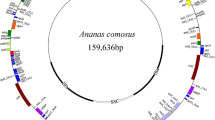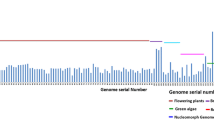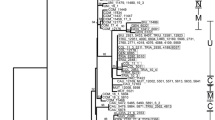Abstract
Simple sequence repeats (SSR) and their flanking regions in the mitochondrial and chloroplast genomes were sequenced in order to reveal DNA sequence variation. This information was used to gain new insights into phylogenetic relationships among species in the genus Oryza. Seven mitochondrial and five chloroplast SSR loci equal to or longer than ten mononucleotide repeats were chosen from known rice mitochondrial and chloroplast genome sequences. A total of 50 accessions of Oryza that represented six different diploid genomes and three different allopolyploid genomes of Oryza species were analyzed. Many base substitutions and deletions/insertions were identified in the SSR loci as well as their flanking regions. Of mononucleotide SSR, G (or C) repeats were more variable than A (or T) repeats. Results obtained by chloroplast and mitochondrial SSR analyses showed similar phylogenetic relationships among species, although chloroplast SSR were more informative because of their higher sequence diversity. The CC genome is suggested to be the maternal parent for the two BBCC genome species (O. punctata and O. minuta) and the CCDD species O. latifolia, based on the high level of sequence conservation between the diploid CC genome species and these allotetraploid species. This is the first report of phylogenetic analysis among plant species, based on mitochondrial and chloroplast SSR and their flanking sequences.


Similar content being viewed by others
References
Akkaya MS, Bhagwat AA, Cregan PB (1992) Length polymorphisms of simple sequence repeat DNA in soybean. Genetics 132:1131–1139
Chin EC, Senior ML, Shu H, Smith JS (1996) Maize simple repetitive DNA sequences: abundance and allele variation. Genome 39:866–873
Dally AM, Second G (1990) Chloroplast DNA diversity in wild and cultivated species of rice (genus Oryza, section Oryza). Cladistic-mutation and genetic-distance analysis. Theor Appl Genet 80:209–222
Doyle JJ, Morgante M, Tingey SV, Powell W (1998) Size homoplasy in chloroplast microsatellites of wild perennial relatives of soybean (Glycine subgenus glycine). Mol Biol Evol 15:215–218
Felsenstein J (1985) Confidence limits on phylogenies: an approach using the bootstrap. Evolution 39:783–791
Hale ML, Borland AM, Gustafsson MH, Wolff K (2004) Causes of size homoplasy among chloroplast microsatellites in closely related Clusia species. J Mol Evol 58:182–190
Ishii T, McCouch SR (2000) Microsatellites and microsynteny in the chloroplast genomes of Oryza and eight other Gramineae species. Theor Appl Genet 100:1257–1266
Jarne P, Lagoda PJL (1996) Microsatellites, from molecules to populations and back. Trends in Ecol Evol 11:424–429
Juliano AB, Naredo MEB, Jackson MT (1998) Taxonomic status of Oryza glumaepatula Steud. I. Comparative morphological studies of New World diploids and Asian AA genome species. Genet Res Crop Evol 45:197–203
Kanno A, Hirai A (1992) Comparative studies of the structure of chloroplast DNA from four species of Oryza: cloning and physical maps. Theor Appl Genet 83:791–798
Khush GS (1997) Origin, dispersal, cultivation and variation of rice. Plant Mol Biol 35:25–34
Kubo T, Nishizawa S, Sugawara A, Itchoda N, Estiati A, Mikami T (2000) The complete nucleotide sequence of the mitochondrial genome of sugar beet (Beta vulgaris L.) reveals a novel gene for tRNACys (GCA). Nucleic Acids Res 28:2571–2576
Moxon ER, Wills C (1999) DNA microsatellites: agents of evolution? Sci Am 280:94–99
Murray MG, Thompson WF (1980) Rapid isolation of high molecular weight plant DNA. Nucleic Acids Res 8:4321–4325
Nishikawa T, Salomon B, Komatsuda T, von Bothmer R, Kadowaki K (2002) Molecular phylogeny of the genus Hordeum using three chloroplast DNA sequences. Genome 45:1157–1166
Notsu Y, Masood S, Nishikawa T, Kubo N, Akiduki G, Nakazono M, Hirai A, Kadowaki K (2002) The complete sequence of the rice (Oryza sativa L.) mitochondrial genome: frequent DNA sequence acquisition and loss during the evolution of flowering plants. Mol Genet Genomics 268:434–445
Palmer JD, Herbon LA (1988) Plant mitochondrial DNA evolves rapidly in structure, but slowly in sequence. J Mol Evol 28:87–97
Soranzo N, Provan J, Powell W (1999) An example of microsatellite length variation in the mitochondrial genome of conifers. Genome 42:158–161
Swofford DL (1998) PAUP*. Phylogenetic analysis using parsimony (*and other methods), version 4. Sinauer Associates, Sunderland
Taramino G, Tingey S (1996) Simple sequence repeats for germplasm analysis and mapping in maize. Genome 39:277–287
Temnykh S, Park WD, Ayres N, Cartinhour S, Hauck N, Lipovich L, Cho YG, Ishii T, McCouch SR (2000) Mapping and genome organization of microsatellite sequences in rice (Oryza sativa L.). Theor Appl Genet 100:697–712
Thompson JD, Gibson TJ, Plewniak F, Jeanmougin F, Higgins DG (1997) The CLUSTAL_X windows interface: flexible strategies for multiple sequence alignment aided by quality analysis tools. Nucleic Acids Res 25:4876–4882
Unseld M, Marienfeld JR, Brandt P, Brennicke A (1997) The mitochondrial genome of Arabidopsis thaliana contains 57 genes in 366,924 nucleotides. Nat Genet 15:57–61
Vaughan DA (1994) The wild relatives of rice. International Rice Research Institute, Manila
Vaughan DA, Morishima H, Kadowaki K (2003) Diversity in the Oryza genus. Curr Opin Plant Biol 6:139–146
Wierdl M, Dominska M, Petes TD (1997) Microsatellite instability in yeast: dependence on the length of the microsatellite. Genetics 146:769–779
Wolfe KH, Li WH, Sharp PM (1987) Rates of nucleotide substitution vary greatly among plant mitochondrial, chloroplast, and nuclear DNAs. Proc Natl Acad Sci USA 84:9054–9058
Acknowledgements
DNA from four O. australiensis (EE genome) and O. brachyantha (FF genome) were kindly provided by Dr. T. Ishii of Kobe University, Japan. We thank Drs. Masood and Ishii for their valuable comments on our results. We thank Ms. Nohara for her technical assistance.
Author information
Authors and Affiliations
Corresponding author
Additional information
Communicated by J.S. Heslop-Harrison
Rights and permissions
About this article
Cite this article
Nishikawa, T., Vaughan, D.A. & Kadowaki, Ki. Phylogenetic analysis of Oryza species, based on simple sequence repeats and their flanking nucleotide sequences from the mitochondrial and chloroplast genomes. Theor Appl Genet 110, 696–705 (2005). https://doi.org/10.1007/s00122-004-1895-2
Received:
Accepted:
Published:
Issue Date:
DOI: https://doi.org/10.1007/s00122-004-1895-2




